Users may be seeking an Ideanote alternative for several reasons:
They may need more guidance after idea collection, such as what evaluation criteria to use, how to validate ideas, and who to involve at each stage. Many tools lack workflows for the steps involved post-idea collection, causing ideas to stall.
They may want to customize workflows based on the type of idea. The steps for launching a new product differ from those for a new business model, but many tools only offer a standardized workflow.
We’ve compiled a list of Ideanote alternatives that address these limitations.
First, we discuss how we designed our innovation management platform, InnovationCast, to offer teams the tools needed to push ideas into implementation.
We also explore other well-regarded solutions, such as Brightidea, Qmarkets, Wazoku, and HYPE Innovation, so you can evaluate their feature sets.
InnovationCast has enabled companies like DHL and Visa to launch innovation programs in under four weeks. Book a 25-minute demo to learn how we can do the same for you.
1. InnovationCast
Innovation Management Software That Supports the Entire Idea Lifecycle

InnovationCast helps companies collect, refine, evaluate, and validate ideas before implementation.
Before creating InnovationCast, we spent over 10 years as innovation managers. During this time, we found that most platforms focus too heavily on idea collection and not enough on the steps that follow. This creates two problems:
Ideas remain dormant in the innovation management system, never realizing their potential as real-world solutions.
Innovation teams export ideas to project management tools or other systems, undermining the company’s culture of innovation. Employees lose visibility into what happens to their ideas and eventually stop contributing.
We created InnovationCast to fill this gap. Its strength lies in configurable workflows that guide teams through the steps following idea collection.
Let’s explore how InnovationCast moves ideas into implementation in more detail, and then we’ll revisit how it helps companies gather high-quality ideas.
Workflows That Structure Post Idea Collection Steps
Our workflows guide teams through evaluating, validating, and implementing ideas.
Each workflow defines the screening questions, evaluation models, scoring methods, experiments, and KPIs to use, based on the nature of the idea.
The key is that different types of ideas require different implementation steps, meaning they need distinct workflows. Yet, many innovation platforms offer only one workflow, forcing teams to push all ideas through the same process.
We designed InnovationCast with multiple workflows, each tailored to different types of ideas, including product ideas, continuous improvement ideas, business model ideas, and more.
Here’s an example of our continuous improvement workflow:
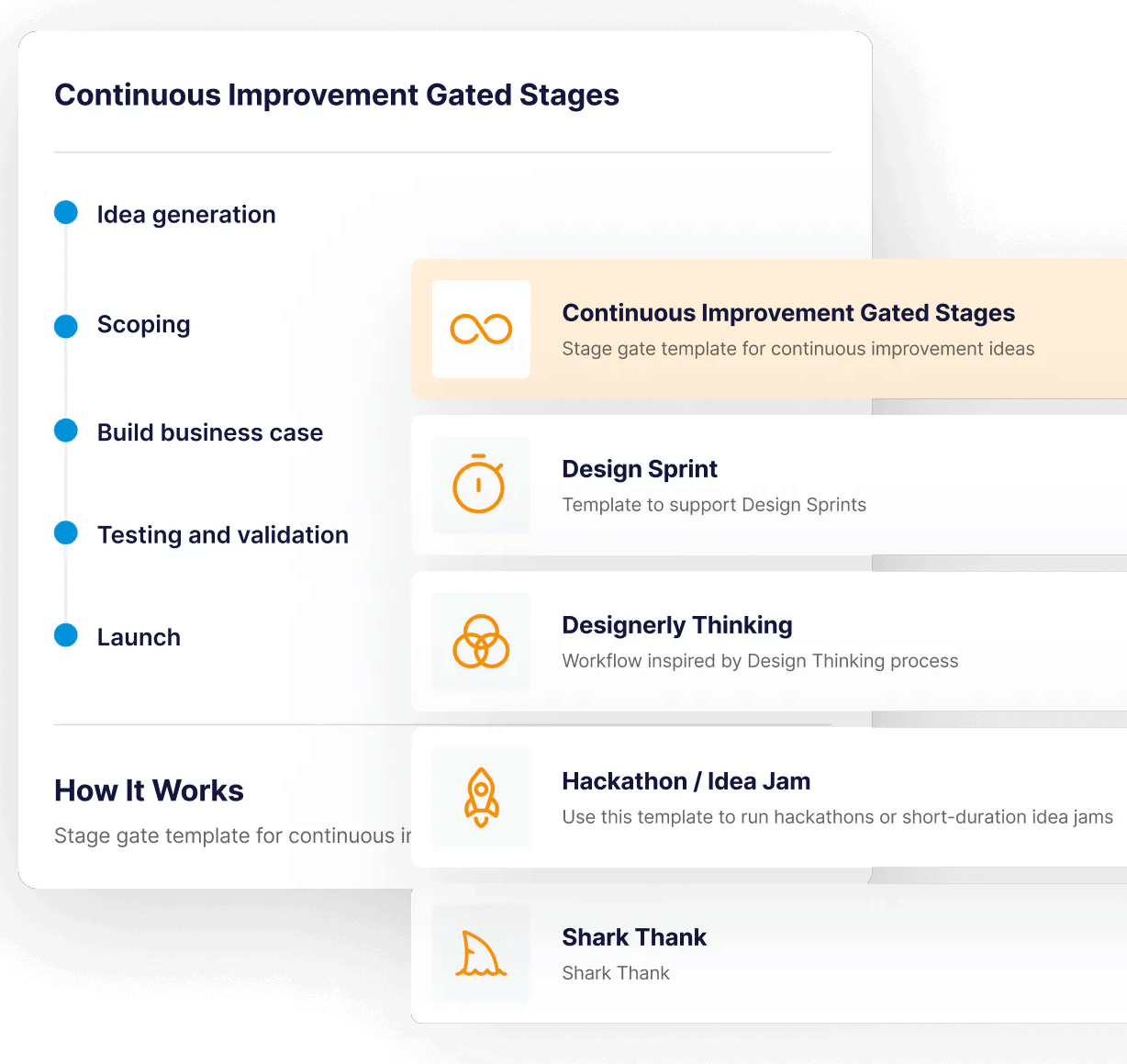
InnovationCast workflows are built on our experience as innovation managers and our firsthand understanding of what works. We also drew inspiration from methodologies like Customer Development, Lean Startup, and Discovery-driven Planning.
Innovation teams can use our workflows out of the box or customize the sequence by adding, removing, or rearranging steps. Teams can even create their own roadmaps from scratch — no coding required.

As tasks are completed within the workflow, InnovationCast automatically notifies the individual or team responsible for the next task that their input is required. These notifications keep ideas moving forward.
Read more: Idea Validation: A Guide to Affordably Testing Ideas
Features That Encourage Users to Submit High-Quality Ideas
There are two ways you can collect ideas with InnovationCast:
Innovation Challenges: This top-down approach enables management to let employees know about their innovation strategy and ask for relevant ideas.
Category-based “Always On”: This bottom-up approach enables employees to surface new opportunities and threats that can potentially change the company’s innovation strategy.
Let’s dig into these further.
Innovation Challenges
Innovation Challenges are calls for ideas that provide context about a priority the company aims to address. When stakeholders launch a challenge, employees (and external users) are invited to review the details and respond with their best ideas.
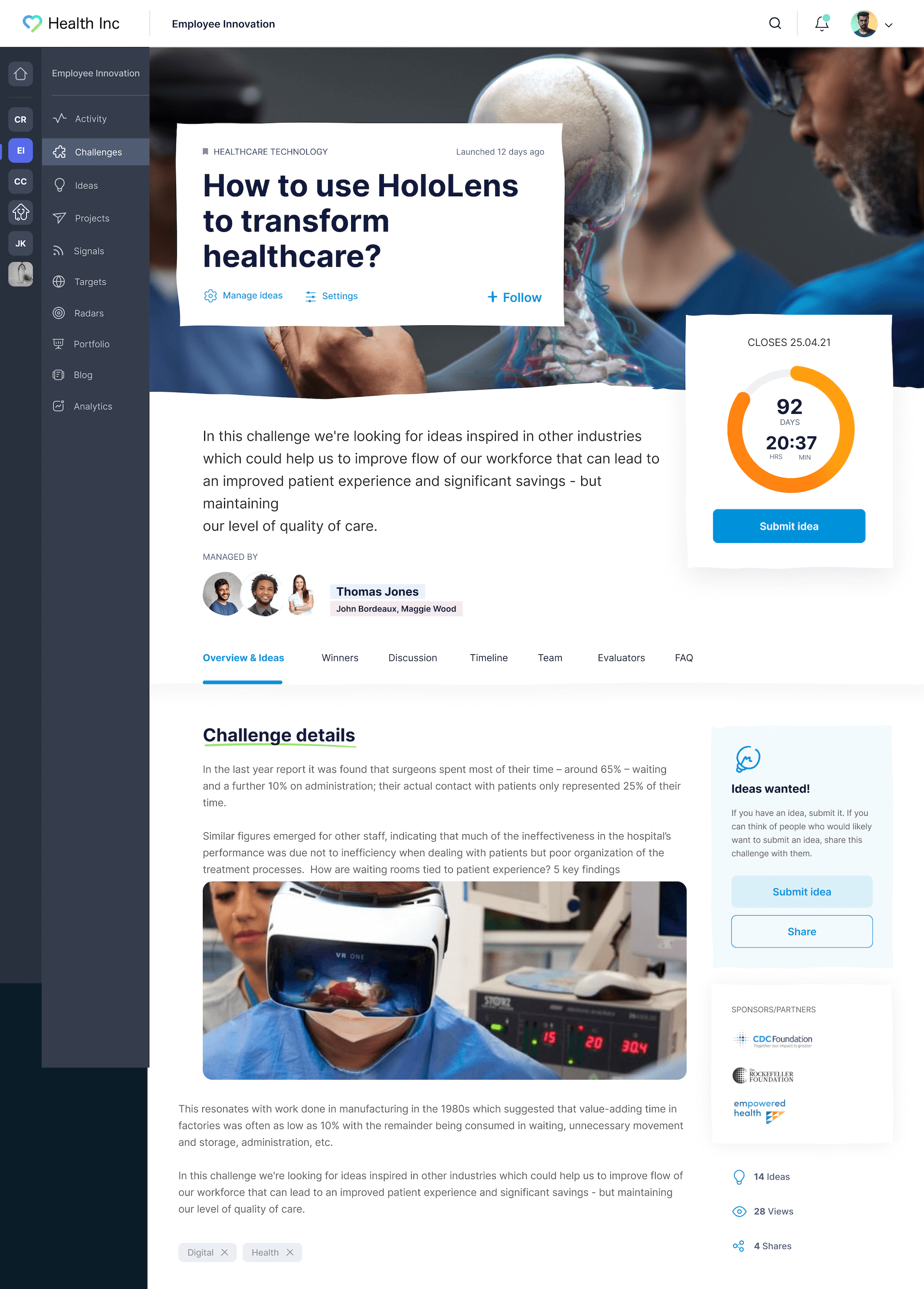
We recommend all clients use Innovation Challenges as their primary method for crowdsourcing ideas. This approach clarifies company priorities for users and ensures they only share relevant ideas, not just any idea that crosses their mind.
There are three features that differentiate InnovationCast from other challenge software:
Guidance tools: We provide examples, checklists, and templates to help you create the best challenges. This guidance is based on our experience as innovation managers.
AI assistance: Our AI feature analyzes the contents of your challenges and suggests improvements. It also reviews user-submitted ideas, offering suggestions to enhance their quality and depth.
Duplicate detection: InnovationCast identifies potential duplicate ideas and prompts users to collaborate with the original author, saving time and eliminating redundancy.
Category-Based “Always On” Idea Collection
Our bottom-up idea collection feature, “Always On,” allows employees to submit broader ideas that may not relate to a specific challenge. This approach can surface new opportunities and threats for management to consider.
Rather than a traditional suggestion box that accepts any idea, you can define specific categories for ideas such as continuous improvement, process innovation, or cost reduction. This ensures users categorize their ideas appropriately, keeping them relevant to key topics of interest.
In the example below, we can see a hospital asking idea authors to bucket their ideas into one of four topics: patient experiences, infection control, new healthcare technology, or sustainable healthcare.

Read more: How to Implement an Effective Idea Generation Process in Your Organization
Features to Improve the Quality of Ideas After Submission
Most ideas aren’t ready to launch immediately after submission and expecting authors to consider every possible angle of their idea in one draft is unrealistic.
That’s why InnovationCast focuses on idea improvement. Instead of sending rough, first-draft ideas directly to evaluators, you can showcase them on the InnovationCast activity feed, allowing other users to provide feedback and refine them.
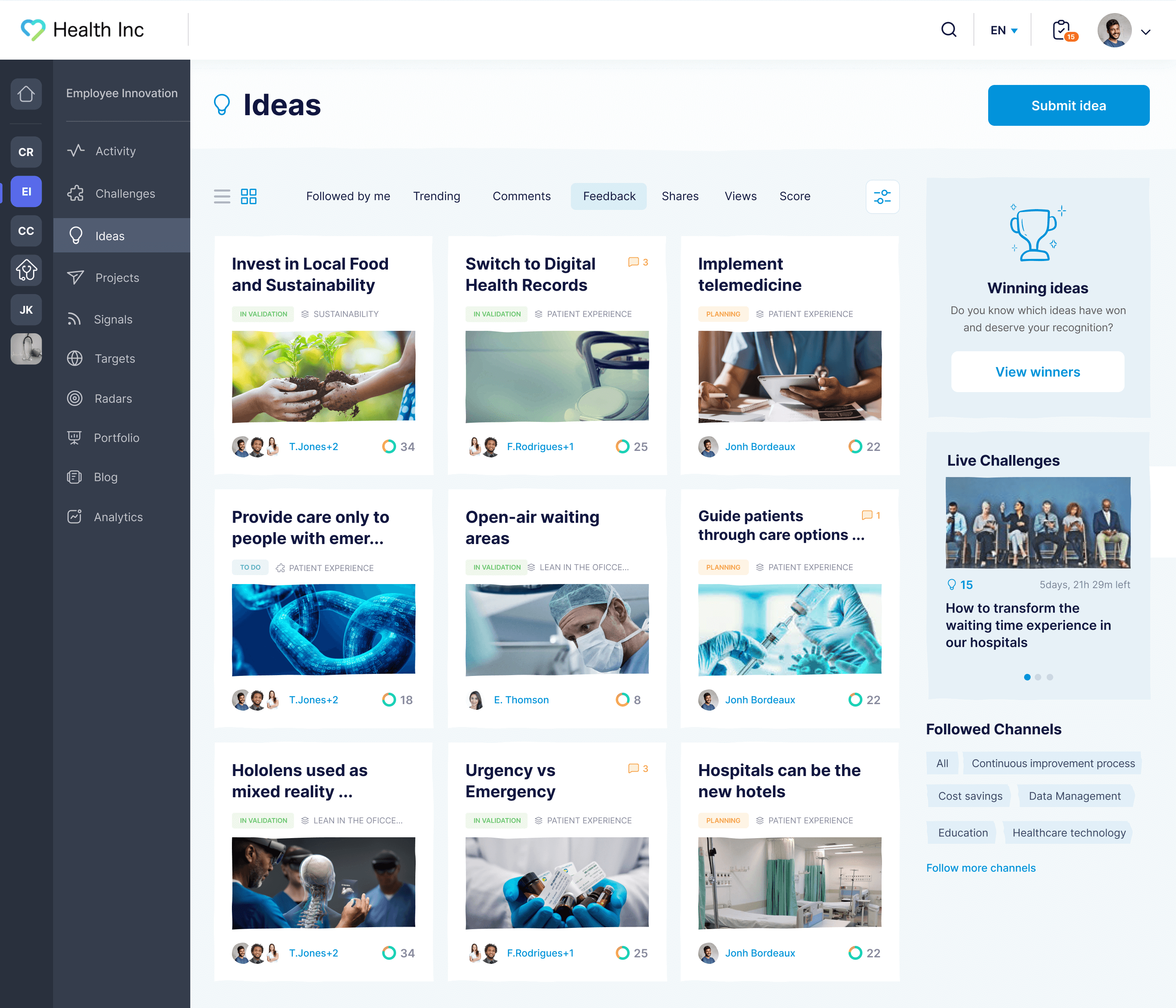
When users log into the collaboration platform, they can review each idea's details, assess its feasibility, potential impact, and risk, and share their thoughts on it.

Unlike most innovation management platforms that rely solely on voting for idea improvement, InnovationCast encourages users to leave feedback for the original author.
The original author can edit their idea to reflect this feedback, effectively improving ideas using expertise from the entire workforce. Employees from customer support, engineering, marketing, legal, finance, and other departments can all participate in the discussion.
Read more: How to Encourage Innovation in the Workplace
Features to Track the Performance of Ideas Once Implemented
A common limitation of many idea management software is their inability to track the ROI of ideas. Instead, they typically track basic participation metrics, such as the number of active projects and idea submissions.
To bridge this market gap, we designed InnovationCast with a robust reporting dashboard that integrates with tools like Tableau, Google Charts, and Microsoft BI. This allows top management to log in and view all implemented ideas, along with their allocated budgets, generated revenue, and ROI.
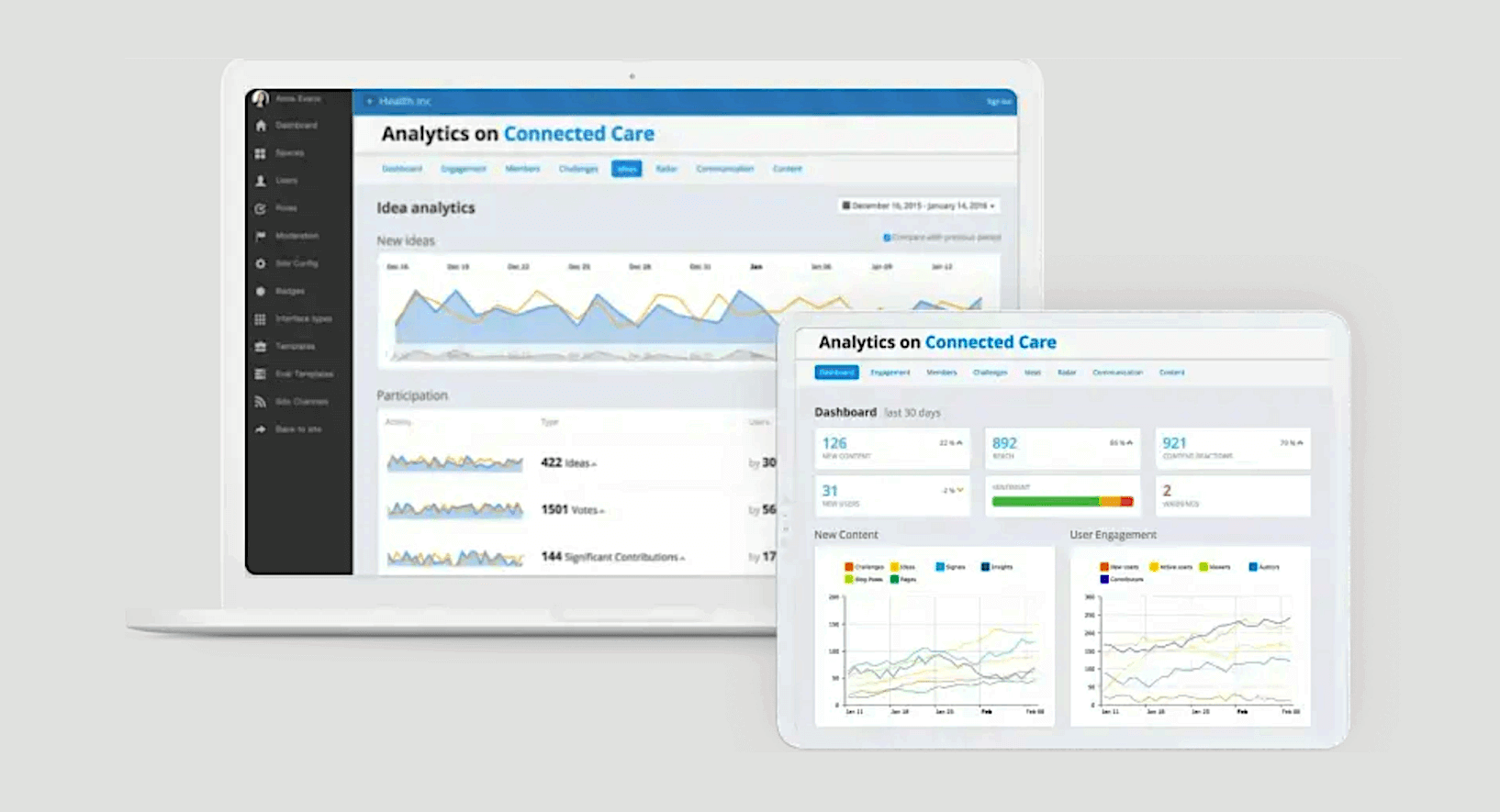
With InnovationCast, stakeholders and innovation managers can easily identify which innovations are generating value and which are falling short. This enables them to reallocate resources based on performance.
The added benefit? They don't need to switch between multiple data visualization tools, even if different teams use different software.
Read more: How to Measure Innovation: Essential KPIs & Best Practices
Features to Help Companies Foster a Culture of Innovation
These additional features in InnovationCast help companies engage employees quickly and establish a vibrant innovation program:
Signals & Scouting
Innovation Radars
Badges & Rewards
Learning resources that drive participation
Signals & Scouting
Signals & Scouting is a trend management feature that helps companies stay on top of competitor updates, emerging startups, new technologies, and other industry news.
Signals & Scouting prompts users to share noteworthy news and insights they believe are valuable. This could be whitepapers, industry reports, infographics, or any other resources.

InnovationCast centralizes these resources within the activity feed — when other users sign in, they can view them, comment, and start discussions with the original contributor about their significance and appropriate next steps.
By getting employees to surface the latest opportunities and threats, companies can address them as soon as they arise.
Signals & Scouting offers an additional benefit: it provides employees who may not have new ideas with an alternative way to participate in innovation. This allows you to draw insights from a wider base of users — extending beyond those with new ideas.
Innovation Radars
Innovation Radars work alongside Signals & Scouting by showing users which topics receive the most entries (e.g., rising startups, competitor news, revolutionary technologies).

For each topic of interest, users can sort them depending on urgency. For example, when submitting Signals about competitor news, users can categorize them as medium-priority, high-priority, or disruptive. This ensures stakeholders know which opportunities or threats to address first.
Badges & Rewards
You can leverage InnovationCast’s Badges & Rewards system to encourage employee participation and acknowledge their efforts. We’ve discovered that rewards are an effective way to kickstart new innovation programs within a company.

With InnovationCast, you can reward users with company perks, extra vacation days, professional development opportunities, or anything else you choose.
Learning Resources That Drive Participation
Many employees misunderstand what innovation truly involves, which can discourage them from participating.
Some think only groundbreaking ideas from scientists and engineers, like the next smartphone or self-driving car, are valued. They don’t realize that continuous improvement is the most common form of innovation and that even small insights, like identifying inefficient processes, can save millions.
To address this, we built educational materials into InnovationCast to help employees understand innovation and assure them their contributions matter.
We deliver these materials in manageable doses: instead of overwhelming employees with long documents, presentations, and videos, we send short, easy-to-read emails. This approach ensures employees can learn without feeling overwhelmed.
As a matter of fact, these resources have helped our clients establish vibrant innovation programs in just under four weeks!
What InnovationCast Clients Say
This is what clients say about our innovation management platform:
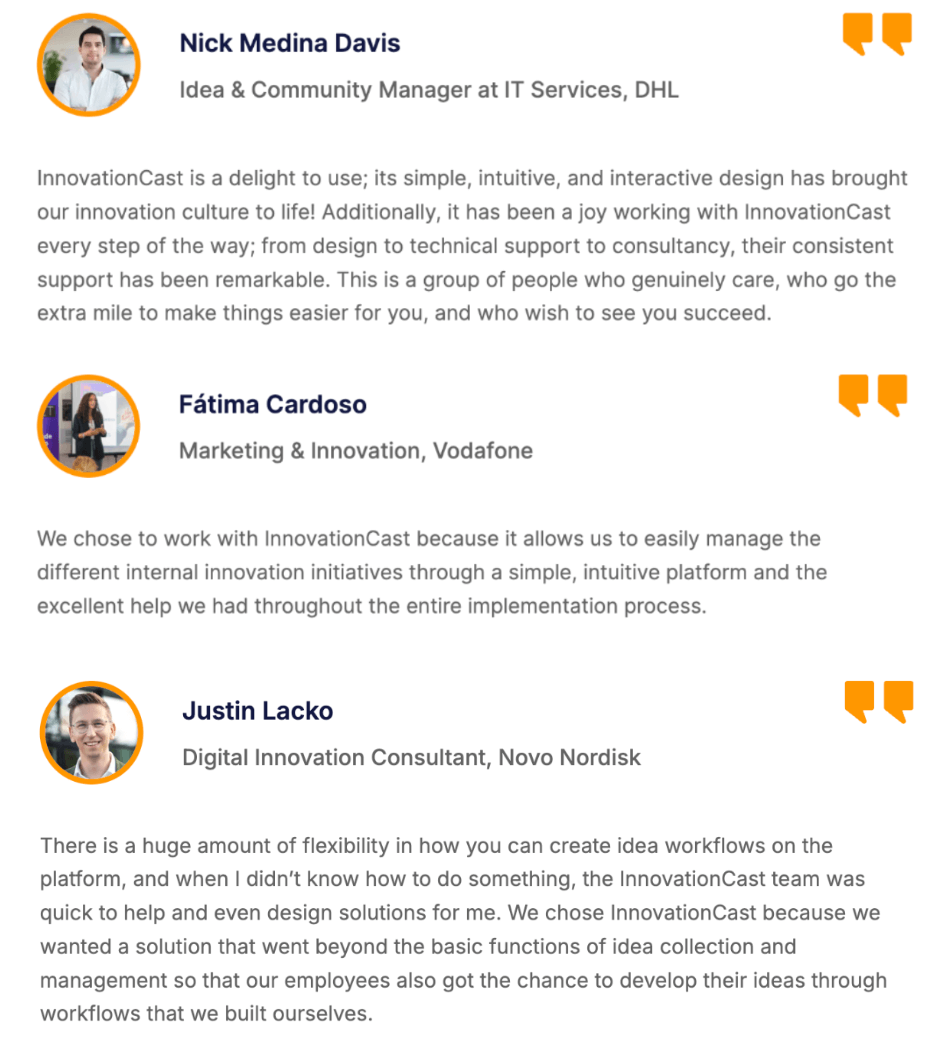
Establish an Innovation Program in Less than 4 Weeks with InnovationCast
The process outlined above has helped clients like DHL gather 67% more ideas and implement 14% more ideas in just four weeks.
Schedule a demo to discover how we can establish an innovation process within your company.
2. Brightidea
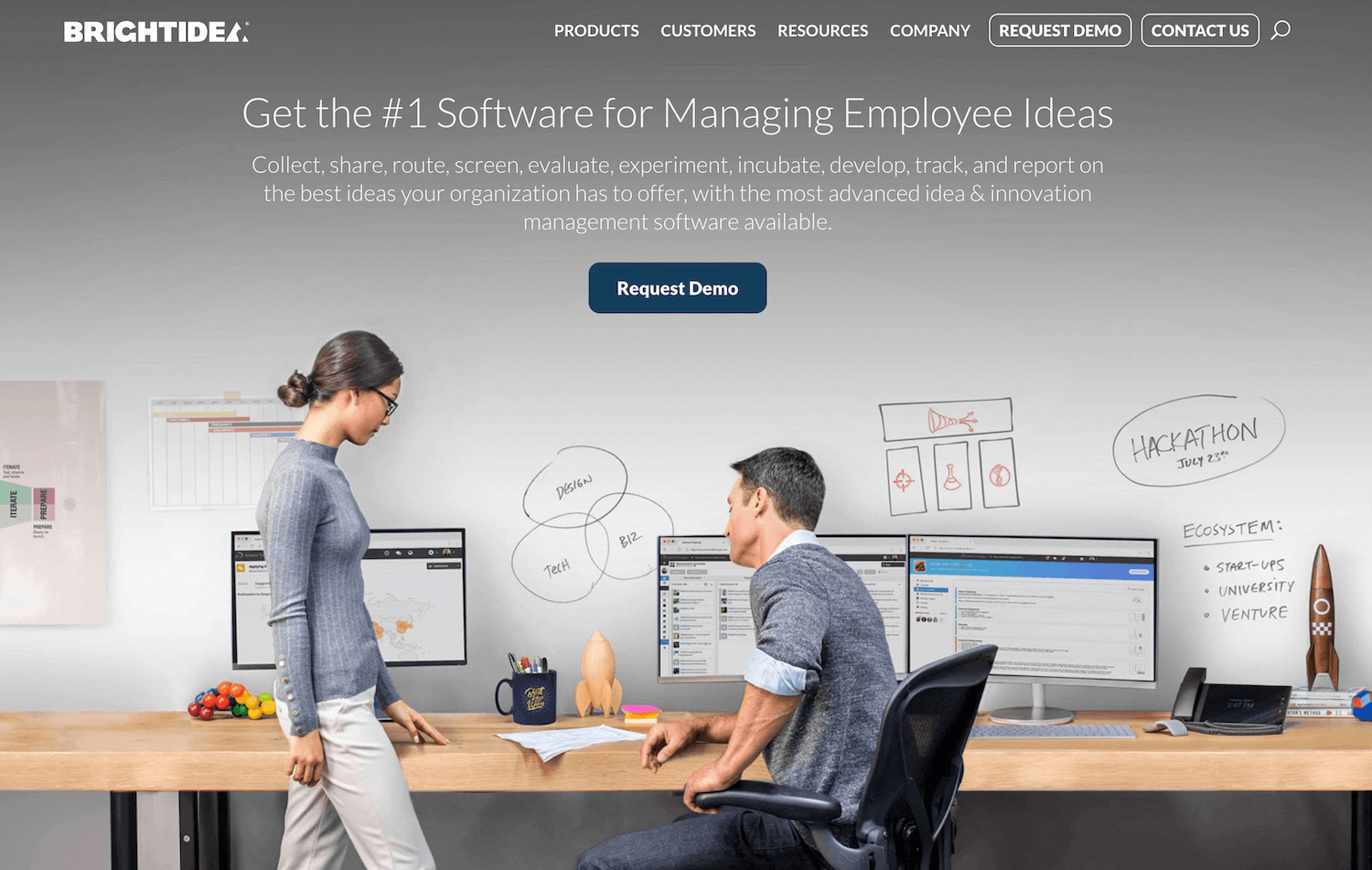
Brightidea is an innovation management platform designed to help enterprises, startups, universities, non-profits, and government entities tap into the creativity of their teams and generate solutions for urgent challenges.
When you start, their team schedules a call to better understand your objectives for launching an innovation program. From there, they customize features like challenges, collaborative creation, workflows, and reporting to align with your goals.
Brightidea also provides a comprehensive suite of tools to guide ideas through every stage of the innovation process, from initial brainstorming to implementation. Their platform includes features like idea ranking, progress tracking, and team collaboration spaces to ensure that promising ideas are acted on.
Features
Idea Box: Brightidea’s idea-gathering tool allows team members and external contributors to suggest solutions for company initiatives and priorities.
Program: Innovation leaders can guide participants on the organization's innovation goals and the ideas they seek. Then, participants are invited to submit ideas.
Lab: Serving as Brightidea’s central idea management hub, this feature allows innovation leaders, team members, and stakeholders to review, assess, and experiment with ideas. Promising concepts can be tested and refined here before moving to the project management phase for execution.
Transformation: This project management tool helps organizations oversee innovation initiatives. Teams can assign responsibilities, set deadlines, and manage resources.
Ecosystem: This open innovation feature connects innovation leaders and stakeholders with startups, enterprises, and funding sources such as sponsors or investors.
3. Qmarkets

Qmarkets is an idea management platform designed for large organizations aiming to foster a culture of innovation across their workforce. It provides tools to manage every stage of the idea lifecycle, from collection and refinement to validation and tracking outcomes.
When you onboard with Qmarkets, their customer success team and innovation consultants collaborate with you to refine your innovation strategy — or help you create one if needed — and tailor the platform to fit your specific requirements.
Features
Idea management: Innovation leaders can gather and organize ideas focused on specific topics using Qmarkets’ system. These ideas can then be shared with others, fostering collaboration and co-creation.
Continuous improvement: Leaders can invite suggestions for improving current products, services, or processes.
Trend management: Team members can share updates about competitors or industry developments, keeping everyone informed and aligned.
Technology scouting: Using Qmarkets’ collaboration features, leaders can connect with universities, startups, and other organizations to develop solutions for complex challenges.
Innovation portfolio: Leaders can gain a comprehensive overview of all active projects, tracking their progress through stages like evaluation, validation, and execution.
4. Wazoku

Wazoku is a cloud-based innovation and idea management platform trusted by organizations like Microsoft, HSBC, Barclays, and Allianz. It offers tools to crowdsource ideas from employees, evaluate and refine them, and guide them through to implementation.
Users particularly appreciate Wazoku's consultation during onboarding, where they help understand your innovation objectives, recommend a pricing plan, and customize the platform to align with your goals.
Features
Internal innovation: A suite of automation tools enables leaders to collect valuable ideas from team members and external contributors using mind mapping and collaboration tools. It includes a reward system to encourage participation and training materials to educate employees on the importance of innovation.
Idea refinement: A user-friendly workspace where team members and external contributors work together to refine and enhance ideas.
Open innovation: Leaders can tap into external expertise to address challenges, tackle priorities, and support initiatives.
Technology scouting: A feature for identifying emerging technologies and connecting with startups for potential partnerships.
Innovation networks: Leaders can leverage Wazoku's community of innovation teams to collaborate on cutting-edge solutions showcased annually at Wazoku's events.
5. HYPE Innovation

HYPE Innovation is a comprehensive innovation management platform that helps organizations of all sizes generate impactful ideas, refine promising concepts, and bring them to life through detailed validation and project management tools.
HYPE’s product lineup includes tools for managing strategic partnerships, a collaborative whiteboard for brainstorming, and an open innovation platform to foster creativity and collaboration.
Features
Strategy: HYPE’s consulting team works with organizations to craft an innovation strategy by pinpointing key areas for improvement.
Ideation: HYPE provides tools like open-ended or time-bound challenges to inspire creativity and encourage employees to contribute innovative ideas. This results in more specific ideas than a context-less Miro, Slack, or Microsoft Teams channel.
Partnering: This feature helps leaders and stakeholders uncover potential business collaborations and investment opportunities in real-time.
Projects: Innovation teams can oversee entire validation initiatives within one dashboard. HYPE includes customizable workflows to guide validation steps and project management tools for turning ideas into real-world solutions.
HYPE also offers an idea management system called Viima, where users can submit ideas, utilize task management features to advance them, and guide decision-making with a comprehensive reporting dashboard.
Get Started
Schedule a 25-minute demo with our customer success team to discover how InnovationCast can help establish a culture of innovation in your business.
Related reads:

